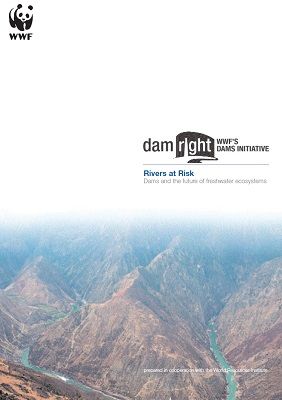Rivers at Risk: Dams and the future of freshwater ecosystems
15 junio 2007
This report analyses the construction and planning of dams on a river basin scale and examines the risks of dams to freshwater ecosystems. It identifies 21 river basins at severe risk of ecological degradation as they have six or more dams over 60 m high planned or under construction in addition to existing dams. Top of the list is the Yangtze River Basin in China with 46 dams, followed by the La Plata River Basin in South America with 27 and the Tigris and Euphrates River Basin with 26, most of these in Turkey. Of particular concern are the cumulative impacts of large numbers of dams in the same basin, especially in smaller basins such as the Salween/Nu River in Myanmar and China.
Dams are both a blessing and a curse. While they provide water and power, they also cause serious damage to freshwater ecosystems, affecting both nature and people. Already, in 60\% of the world’s major rivers flows are interrupted by dams, canals and diversions.
Many freshwater habitats and species have been lost, with dams and their associated infrastructure, such as irrigation systems, a major culprit. Dam construction has mainly shifted from the developed to the developing world, with countries such as China and India implementing large dam construction programmes, including interbasin transfers. While water and energy requirements in developing countries are real and need to be addressed, the risk to ecosystems is acute and unique species and habitats are threatened.
Migratory fish, river dolphins and water birds are particularly vulnerable, as are the people who depend on these ecosystems for their livelihoods, for example through fisheries. Those most affected by dams still rarely benefit directly and often remain without access to power and clean water. Meanwhile, too much of the water provided by dams is wasted, especially by inefficient agricultural irrigation systems. To avoid large-scale damage, decision-making needs to be informed by a comprehensive assessment of all options, alternatives and impacts. This should include careful site choice, a cumulative assessment of dams by river basin, as well as extensive mitigation measures for those dams that are given the go-ahead. Integrated River Basin Management (IRBM) provides the tools to assess and avoid basin wide impacts and meet the needs of a range of stakeholders, yet is still far from commonly applied. The World Commission on Dams (WCD) has provided a set of recommendations to improve decision-making on dam development, but these are still not implemented in most countries. Without an effective assessment of options and alternatives, there is a real danger that many current dam projects will have unacceptable and unnecessary costs, repeating the mistakes of past projects that, according to the WCD, often could have been avoided. Best practice examples from around the globe demonstrate that it is possible to strike a balance between water and energy needs and environmental protection. WWF is calling on governments and dam developers to follow these examples by applying the WCD recommendations and cumulative environmental impact assessments. It is their responsibility to ensure that water and energy needs are met in a sustainable manner without the destruction of the very ecosystems that provide the basis of a clean and stable water supply.


